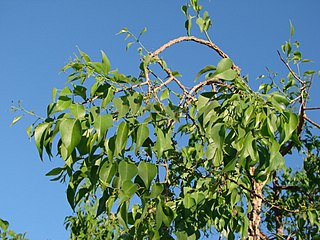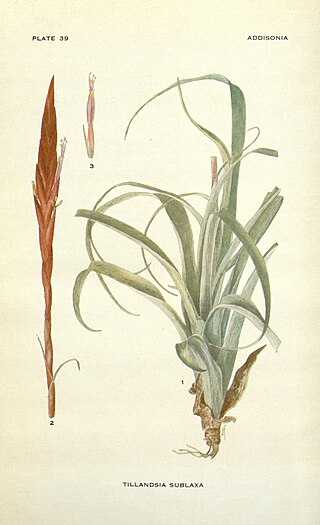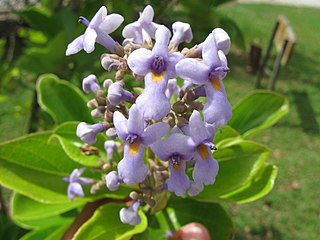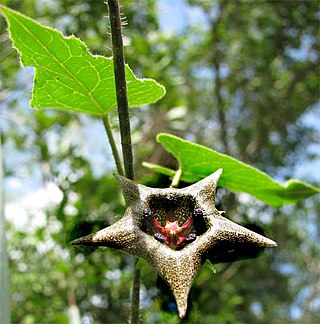Bernardia is a plant genus of the family Euphorbiaceae first described for modern science as a genus in 1754. It is native to North and South America, as well as the West Indies.

Triuridaceae are a family of tropical and subtropical flowering plants, including nine genera with a total of approximately 55 known species. All members lack chlorophyll and are mycoheterotrophic. The heterotrophic lifestyle of these plants has resulted in a loss of xylem vessels and stomata, and a reduction of leaves to scales.

Agonandra is a genus of plants in the family Opiliaceae described as a genus in 1862.

Renealmia is a plant genus in the family Zingiberaceae. Its members are native to tropical Africa and tropical America. In Peru, fruits and tubers are sources of indigenous dyes. and indigenous medical treatments for leishmania and malaria In Colombia, it is used to treat snakebite. Bracts and leaves can serve as phytotelmata, retaining small quantities of water that offer habitat for other organisms.

Teuscheria is a genus of orchids native to southern Mexico, Central America and northern South America. The genus is named for Henry Teuscher, an award-winning landscape artist and horticulturalist.

Lacandonia is a mycoheterotrophic plant that contains no chlorophyll and has the unusual characteristic of inverted positions of the male (androecium) and female (gynoecium) floral parts, something that had not been seen in any other plants, with the exceptions of Trithuria and on occasion the related Triuris brevistylis.

Brassia maculata, the spotted brassia, is a species of orchid. It is native to southern Mexico, Central America, Cuba, and Jamaica.

Eulophia alta is a species of orchid, known as the wild coco. It is widespread across tropical and subtropical parts of Africa, South America, Central America, Mexico and the West Indies, as well as the southeastern United States.

Jouvea is a Latin American genus of coastal plants in the grass family. It grows on mud flats and coastal sand dunes from northern Mexico to Ecuador.

Tillandsia variabilis, the leatherleaf airplant, is a species of bromeliad in the genus Tillandsia. This species is native to Bolivia, Costa Rica, Mexico, Venezuela, Colombia, the West Indies and southern Florida.

Triphora is a genus of flowering plants from the orchid family, Orchidaceae. It is native to South America, Central America, southern Mexico, the West Indies and eastern North America as far north as Ontario. Noddingcaps is a common name for plants in this genus.
- Triphora amazonicaSchltr. - Florida, Caribbean, south to Brazil
- Triphora carnosula(Rchb.f.) Schltr. - Brazil
- Triphora craigheadiiLuer - Florida
- Triphora debilis(Schltr.) Schltr. - southern Mexico, Costa Rica, Guatemala, Panama
- Triphora duckeiSchltr. - Brazil
- Triphora foldatsiiCarnevali - Venezuela
- Triphora gentianoides(Sw.) Nutt. ex Ames & Schltr. - Florida, Southern Mexico, Costa Rica, Veenzuela, Colombia, Ecuador, Bahamas, Greater Antilles
- Triphora hassleriana(Cogn. ex Chodat & Hassl.) Schltr. - from Mexico to Argentina
- Triphora heringeriPabst - Brazil
- Triphora miserrima(Cogn.) Acuña - Cuba, Hispaniola
- Triphora nitida(Schltr.) Schltr. - Costa Rica
- Triphora pusilla(Rchb.f. & Warm.) Schltr. - Brazil
- Triphora ravenii(L.O.Williams) Garay - Costa Rica, Panama
- Triphora santamariensisPortalet - Brazil
- Triphora surinamensis(Lindl. ex Benth.) Britton - West Indies south to Brazil
- Triphora trianthophoros(Sw.) Rydb. Ontario, Eastern United States, much of Mexico
- Triphora unifloraA.W.C.Ferreira, Baptista & Pansarin - Brazil
- Triphora wagneriSchltr. - from Mexico to Ecuador
- Triphora yucatanensisAmes - Florida and the Yucatán Peninsula

Sarcoglottis is a genus of flowering plants from the orchid family, Orchidaceae. It is widespread across much of Latin America from Mexico to Argentina, with one species extending northward into Trinidad and the Windward Islands.

Ionopsis utricularioides, the delicate violet orchid, is an epiphytic orchid native to the warmer parts of the Americas. It is reported from Florida, Mexico, Central America, much of the West Indies including the Cayman Islands, South America as far south as Paraguay, and the Galápagos.

Cornutia is a genus of plants in the family Lamiaceae, first described in 1753. Species in this genus are native to tropical parts of the Western Hemisphere, including southern Mexico, Central America, the West Indies, and northern South America.

Dictyanthus is a genus of plant in family Apocynaceae, first described as a genus in 1844. It is native to Mexico and Central America.
Brickellia diffusa is a Latin American species of flowering plants in the family Asteraceae. It is widespread across much of South America, Central America, Mexico, Galápagos, and the West Indies. Its distribution stretches from Sonora and Tamaulipas in northern Mexico to Jujuy in northern Argentina.
Cirsium mexicanum is a Mesoamerican and Caribbean species of plants in the tribe Cardueae within the family Asteraceae. Common name is Mexican thistle. It is widespread across Mexico, Central America and the West Indies.

Erechtites valerianifolius, common name tropical burnweed is a New World species of plants in the sunflower family. It is native to Mexico, Central America, South America, and the West Indies. It is also naturalized as a weed in much of the tropical Old World.

Xyris jupicai, common name Richard's yelloweyed grass, is a New World species of flowering plant in the yellow-eyed-grass family. It is widespread in North America, South America, Mesoamerica, and the West Indies.

Malaxis histionantha is a species of orchid native to Latin America. It is widespread from Mexico to Argentina. It generally has two leaves and a more or less spherical cluster of small green flowers.
















